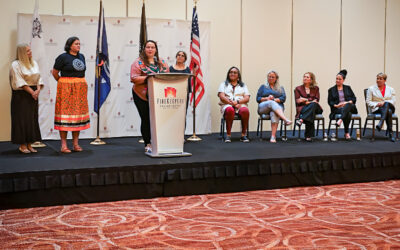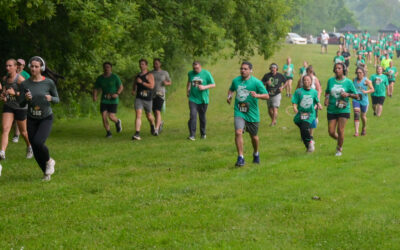Representing Traditional Lifeways
Anishinaabe Culture Day at the Grand Rapids Public Museum delivered a full day of hands-on educational activities and demonstrations, all to represent what it means to be Anishinaabe accurately.
“Representation is important,” said NHBP Northern Office Culture & Membership Services Supervisor Camie Castaneda during an interview with WZZM 13 at the event. “We wanted to make sure that our youth is represented, that they are proud.”
NHBP Northern Administration Office proudly partnered with the Anishinaabe Circle and the City of Grand Rapids to host this event for the fourth time on Oct. 13.
Throughout the day, NHBP Tribal Members and Team Members, and other Anishinaabe, demonstrated their Cultures through various activities to the 1,100 registered elementary school students, parents and educators who attended from all over West Michigan.
“The number of registrants has more than doubled from last year,” said the museum’s Public Program Specialist Rob Schuitema, citing the growing interest in Traditional lifeways and the accurate history of Michigan and its Indigenous people.
Students from Grand Rapids Public Schools, Northpointe Christian Schools, Palmer Elementary School, and homeschooled children, poured into the morning sessions at the museum.
“I discovered this opportunity through a homeschooling Facebook group,” said a parent educator from Rockford, Michigan. “Learning about the history of Michigan is part of our current curriculum, and we learn so much better hands-on.”
While working with their hands, attendees created corn husk dolls with Maddy BigBear and Pretty Rock BigBear, both Pokagon Band, on the museum’s first floor. Participants also viewed displays of Traditional jewelry, baskets and bowls stationed around the museum, representing Anishinabék traditions, including the work of Courtney Biggs, Cherokee/Anishinaabe.
Biggs’ craftsmanship is a familiar and beloved sight within the NHBP Community, as it adorns the NHBP Tribal Council Chambers. During Culture Day, Biggs displayed his famous Beechwood bowls, mugs and décor, each with a special meaning and a personal touch.
“I like your artwork,” praised one student as she walked by Biggs’ table on the way to the Dancing presentation.
At the top of each hour, students, chaperones and educators alike were agog with the Dancing, Drumming and Singing presentations, with the Drumming and Singing performed by NHBP Tribal Members Southern Strait Drum – Owen Zapata, Arthur Zapata and Paul Syrette.
Held in the Meijer Theater and emceed by NHBP Language Coordinator Mike Medawis, Little River Band, each 45-minute session caused more than the 200 students to become spellbound once the Drums began to play.
“Why are the Drums so loud?” was commonly asked by young students during the Question and Answer portion.
“Because we are proud, and these are our prayers, and the loud beat you hear is the honor beat to call our Spirits,” explained Medawis to the students.
“We also play with a loud beat so that the Dancers can keep time,” said the members of Southern Strait.
The youth Dancers represented many different Tribes’ styles of Regalia and Dancing, some of which included Comanche, Lakota, Ho-chunk and Bay Mills Indians.
“We made sure that we had a full youth Dance troupe because we wanted to relate to the kids who were coming in,” said Castaneda.
The youth performed a “mini-Grand Entry,” demonstrating a Pow Wow, Dancing in a circle on the stage. The Dancing included the Women’s Traditional, the Men’s Traditional, the Women’s Jingle, the Grass Dance and the closing performances of both the Men’s and the Women’s Fancy Dance.
Massive applause erupted at the end of the performances, followed by a big “Migwetch!” from the audience, most of who had just learned the word from Medawis that morning.
Madalene BigBear, Pokagon Band, held a storytelling presentation in the Chaffee Planetarium for the attendees. Illustrations lit up the domed screen, complementing the teachings.
“Bozho. Saying hello to any relatives,” said BigBear as she introduced herself to the crowd.
She shared the story of Ojit, the Fisher, whose plucky courage helped remove the permanent Winter and provide for the changing seasons today. Attendees also heard the story of Skunk, whose self-love and self-interest caused her to be thrown into the fire by Bear, causing her to be smelly and with a black stripe down her back. BigBear also told them about the large Hawks abducting children who wear red, citing that as the reason why Potawatomi kids never wear red shirts.
The Culture Day garnered much media attention, with three local TV stations covering the event, including coverage by WZZM 13: Anishinaabe Culture Day celebrated at Grand Rapids Public Museum Wednesday | wzzm13.com.




0 Comments